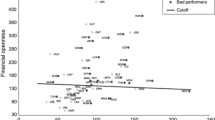Abstract
This paper examines various measures of synchronization of recessions, including clustering of the onset of and exit from recession across economies, the proportion of economies in expansion, and the diffusion index of international coincident indexes. It shows that the recent COVID recession and recovery were the most concerted in the post-world war period. Factors that contributed to the synchronization and severity of the recession, such as common shocks, trade and supply chain dynamics, and financial linkages, are analyzed.
Access this chapter
Tax calculation will be finalised at checkout
Purchases are for personal use only
Similar content being viewed by others
Notes
- 1.
A recession is a vicious cycle of pronounced, pervasive, and persistent cascading declines in output, income, employment, and sales, eventually giving way to an expansion, which is an analogous virtuous cycle of rising economic activity. Sometimes, an economy exhibits not a recession but a milder counterpart called a slowdown, meaning a downshift in the pace of positive growth in economic activity. The transitions between the vicious and virtuous cycles are the peaks and troughs in the cycle, also known as cyclical turning points.
- 2.
Coincident indicators are those that move reliably in step with the economy, so their peaks and troughs roughly coincide with those of the economy itself. A coincident index for a particular economy comprises various coincident indicators that collectively represent the current state of the economy. It indicates whether the economy is currently expanding or is in a recession. It is a summary measure designed to track fluctuations in aggregate economic activity that make up the business cycle. Thus, a coincident index can be used to decide the phase of the business cycle the economy is in at a given point in time. The index can therefore be used to help determine the timing of recessions and expansions, as well as speedups and slowdowns in the economy. Classical business cycles measure the ups and downs of the economy, with the absolute levels of coincident indicators constituting the coincident index.
- 3.
The timing of recessions and expansions of business cycles is determined on the basis of a careful consideration of the consensus of cyclical co-movements in the coincident indicators that comprise the coincident index. (Details are described in Dua and Banerji, 1999, 2004, 2007). A specific cycle, that is, a set of turning points for each series, is obtained. A reference cycle chronology is then determined based on the central tendency of the individual turning points in a set of coincident economic indicators. A reference cycle based on the levels of the coincident indicators thus gives the consensus of turning points of the coincident indicators.
- 4.
The GFC, or Global Financial Crisis, was global by definition, but it was not in the nature of an economic cycle, though it strongly influenced economic cycles around that time. While some might consider the GFC to have begun with the Lehman Brothers collapse in mid-September 2008, there is no objective way to determine its precise end date. In other words, unlike recessions, the GFC did not have specific start and end dates that can be determined in an analogous fashion. Also, the term “Great Recession” is not synonymous with the GFC since it is specific to the US, and during that period in 2007–09, some economies like China, India, Australia, and Poland did not experience any recessions.
References
Banerji, A., & Dua, P. (2010). The synchronization of recessions in major developed and emerging economies. Margin: The Journal of Applied Economic Research, 4(2), 197–223.
Dua, P., & Banerji, A. (1999). An index of coincident economic indicators for the Indian economy. Journal of Quantitative Economics, 15, 177–201.
Dua, P., & Banerji, A. (2004). Monitoring and predicting business and growth rate cycles in the Indian economy. In Dua, P (Ed.), Business cycles and economic growth: An analysis using leading indicators. Oxford University Press.
Dua, P., & Banerji, A. (2007). Business cycles in India. In Basu, K (Ed.), Oxford companion to economics in India, Oxford University Press.
Economic Cycle Research Institute. (2019). International Cyclical Outlook Essentials, XXIV (6), 1–4
Mack, R. (1956). Consumption and business fluctuations: A case study of the shoe, leather, hide sequence, National Bureau of Economic Research.
Author information
Authors and Affiliations
Corresponding author
Editor information
Editors and Affiliations
Rights and permissions
Copyright information
© 2023 The Author(s), under exclusive license to Springer Nature Singapore Pte Ltd.
About this chapter
Cite this chapter
Banerji, A., Dua, P. (2023). The Increasing Synchronization of International Recessions. In: Dua, P. (eds) Macroeconometric Methods. Springer, Singapore. https://doi.org/10.1007/978-981-19-7592-9_13
Download citation
DOI: https://doi.org/10.1007/978-981-19-7592-9_13
Published:
Publisher Name: Springer, Singapore
Print ISBN: 978-981-19-7591-2
Online ISBN: 978-981-19-7592-9
eBook Packages: Economics and FinanceEconomics and Finance (R0)




